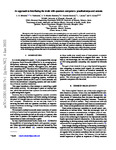An approach to interfacing the brain with quantum computers: practical steps and caveats
| dc.contributor.author | Miranda, E | |
| dc.contributor.author | Venkatesh, S | |
| dc.contributor.author | Martin-Guerrero, JD | |
| dc.contributor.author | Hernani-Morales, C | |
| dc.contributor.author | Lamata, L | |
| dc.contributor.author | Solano, E | |
| dc.date.accessioned | 2022-02-08T12:43:17Z | |
| dc.date.issued | 2022-01-05 | |
| dc.identifier.issn | 1548-7202 | |
| dc.identifier.issn | 1548-7202 | |
| dc.identifier.uri | http://hdl.handle.net/10026.1/18683 | |
| dc.description.abstract |
We report on the first proof-of-concept system demonstrating how one can control a qubit with mental activity. We developed a method to encode neural correlates of mental activity as instructions for a quantum computer. Brain signals are detected utilizing electrodes placed on the scalp of a person, who learns how to produce the required mental activity to issue instructions to rotate and measure a qubit. Currently, our proof-of-concept runs on a software simulation of a quantum computer. At the time of writing, available quantum computing hardware and brain activity sensing technology are not sufficiently developed for real-time control of quantum states with the brain. But we are one step closer to interfacing the brain with real quantum machines, as improvements in hardware technology at both fronts become available in time to come. The paper ends with a discussion on some of the challenging problems that need to be addressed before we can interface the brain with quantum hardware. | |
| dc.format.extent | 159-171 | |
| dc.language | English | |
| dc.language.iso | English | |
| dc.publisher | Old City Publishing | |
| dc.subject | Brain-Computer Interface | |
| dc.subject | Computer Science | |
| dc.subject | Neuroscience | |
| dc.subject | Quantum computing | |
| dc.title | An approach to interfacing the brain with quantum computers: practical steps and caveats | |
| dc.type | journal-article | |
| dc.type | Article | |
| plymouth.author-url | https://www.webofscience.com/api/gateway?GWVersion=2&SrcApp=PARTNER_APP&SrcAuth=LinksAMR&KeyUT=WOS:000808377700001&DestLinkType=FullRecord&DestApp=ALL_WOS&UsrCustomerID=11bb513d99f797142bcfeffcc58ea008 | |
| plymouth.issue | 3 | |
| plymouth.volume | 17 | |
| plymouth.publisher-url | https://www.oldcitypublishing.com/wp-content/uploads/2022/02/IJUCv17n3p159-171Miranda.pdf | |
| plymouth.publication-status | Published | |
| plymouth.journal | International Journal of Unconventional Computing | |
| plymouth.organisational-group | /Plymouth | |
| plymouth.organisational-group | /Plymouth/Faculty of Arts, Humanities and Business | |
| plymouth.organisational-group | /Plymouth/Faculty of Arts, Humanities and Business/School of Society and Culture | |
| plymouth.organisational-group | /Plymouth/REF 2021 Researchers by UoA | |
| plymouth.organisational-group | /Plymouth/REF 2021 Researchers by UoA/UoA33 Music, Drama, Dance, Performing Arts, Film and Screen Studies | |
| plymouth.organisational-group | /Plymouth/Users by role | |
| plymouth.organisational-group | /Plymouth/Users by role/Academics | |
| dcterms.dateAccepted | 2021-12-29 | |
| dc.rights.embargodate | 2022-2-19 | |
| dc.identifier.eissn | 1548-7202 | |
| dc.rights.embargoperiod | Not known | |
| rioxxterms.funder | Engineering and Physical Sciences Research Council | |
| rioxxterms.identifier.project | QCS Hub | |
| rioxxterms.version | Accepted Manuscript | |
| rioxxterms.licenseref.uri | http://www.rioxx.net/licenses/all-rights-reserved | |
| rioxxterms.licenseref.startdate | 2022-01-05 | |
| rioxxterms.type | Journal Article/Review | |
| plymouth.funder | QCS Hub::Engineering and Physical Sciences Research Council |


